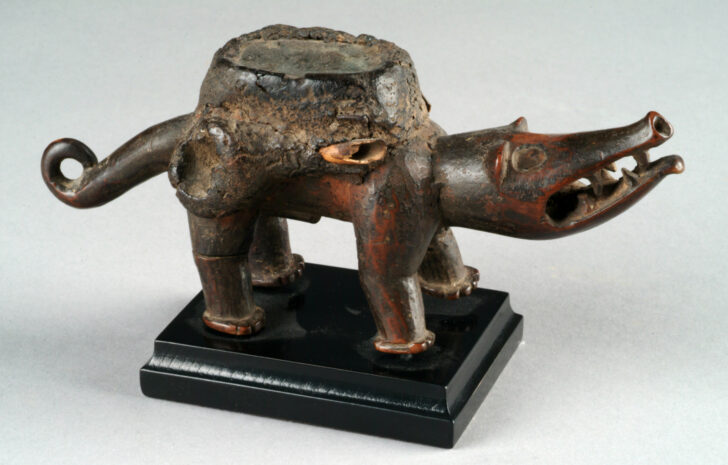Power Figure
Vili (Kongo)

Description
March 28, 2009
This power figure probably represents a dog. In Vili and other communities in central Africa, dogs live in villages and hunt in forests. Thus, they were thought to move freely between the worlds of the living and the dead, their keen sense of smell and sight granting them vision into otherworldly events. Used by ritual specialists to heal or to detect and redress misfortune, the mirror-topped medicine pack worked like a window into the ancestral realm. Spiritually charged materials like grave dirt, riverbed clay, shells, and herbs emboldened the forces within it. The coiled tail, curled lower lips and snout, and flexed knees give this tiny figure vitality.
Subject Matter:
Nkisi kozo is a type of nkisi, the most numerous and best-documented Kongo visual form. The term nkisi refers to both the spirit personality (pl. bakisi) controlling a particular activity or function as well as to the physical object (pl. minkisi) serving as an intermediary vehicle through which the spirit personality is accessed in order to fulfill a specific need for the living. Minkisi are designed, operated, and controlled by an nganga (pl. banganga), an expert healer and mediator of spirits and forces. Minkisi are of multiple types and, in general, fall under two broad categories: those who have a benevolent function promoting health and prosperity and those who have an aggressive or violent nature. Kozo, which refers to a certain type of large, coastal dog, fall into this latter category and often assist an nkondi (“hunter”, pl. minkondi) in tracking down enemies and attacking wrongdoers.
In Kongo thought, dogs have the ability to traverse both the village (the domain of the living) and the forest (the domain of the deceased). They are said to possess “four eyes” – two for this world and two for the spirit world – hence, the reason why many kozo feature heads that face in two directions. Various kozo are pounded with mbau (nails, screws, blades, and other hardware), are armed with “guns” of hollow cane filled with gun powder, and carry medicinal substances (bilongo) comprised of a variety of vegetable, animal, and mineral ingredients meticulously chosen by the nganga on behalf of the client.
This particular kozo stands in an active, energetic pose, evidenced by its curled tail. It
has eyes which include small mirrors and feature white kaolin clay (mpemba). Mirrors serve as the medium by which kozo can see; its glittered reflection also deflects evil forces. Kaolin typically signifies the deceased and the land of the dead. Sealed on the dog’s back is a large, mirror-topped medicine pack. This mirror likely acted as a compass for the nganga indicating which direction danger lay. In addition, there are two cavities on top of both hind legs which probably held packets of bilongo. The kozo is equipped with two 'guns' on either side of its front legs with which it can strike adversaries.
References:
African Form and Imagery: Detroit Collects. Ed. Judith A. Ruskin. Detroit: Detroit Institute of Arts Founders Society, 1996.
Felix, Marc Leo. 100 Peoples of Zaire and Their Sculpture: A Handbook. Brussels: Zaire Basin Art History Research Foundation, 1987.
Felix, Marc Leo. 1Art et Kongos. Brussels: Zaire Basin Art History Research Center, 1995.
A History of Art in Africa. 2nd Edition. Eds. Monica Visona, Robin Poynor, and Herbert Cole. Upper Saddle River, NJ: Pearson Education, Inc., 2008.
LaGamma, Alisa. Art and Oracle: African Art and Rituals of Divination. New York: The Metropolitan Museum of Art, 2000.
MacGaffey, Wyatt. Email Correspondence with Allyson Purpura. July 15, 2007.
MacGaffey, Wyatt. Excerpt from an Unknown Publication in Object Folder for 2005/1.191.
MacGaffey, Wyatt and Michael Harris. Astonishment and Power: Kongo Minkisi & The Art of Renee Stout. Washington, DC: Smithsonian Institution Press, 1993.
Maurer, Evan M. and Niangi Batulukisi. Spirits Embodied: Art of the Congo, Selections from the Helmut F. Stern Collection. Minneapolis: The Minneapolis Institute of Arts, 1999.
McClusky Pamela. Art from Africa: Long Steps Never Broke a Back. Seattle and Princeton: Seattle Art Museum in association with Princeton University Press, 2002.
Simon, Kavuna and Wyatt MacGaffey. “Northern Kongo Ancestor Figures.” African Arts. 28:2 (Spring 1995): pp. 48-53+91.
Unknown Publication found in Object Folder of 2005/1.191. [Heading on the front page is "Karl Edward Laman"; no other bibliographic information is given.]
Physical Description:
This small figure is that of a dog who has short legs, a thick, curled tail, small ears, and an elongated muzzle. Its mouth is open with pointed teeth bared and tongue slightly hanging. Its eyes include small mirrors and feature the white mineral kaolin. On the dog’s back is a large, mirror-topped medicine pack which has been sealed with resin. There are two recesses on top of both hind legs which also likely held packets of medicine. Near the top of the two front legs are hollow projections, which have broken off.
Usage Rights:
If you are interested in using an image for a publication, please visit https://umma.umich.edu/request-image/ for more information and to fill out the online Image Rights and Reproductions Request Form.